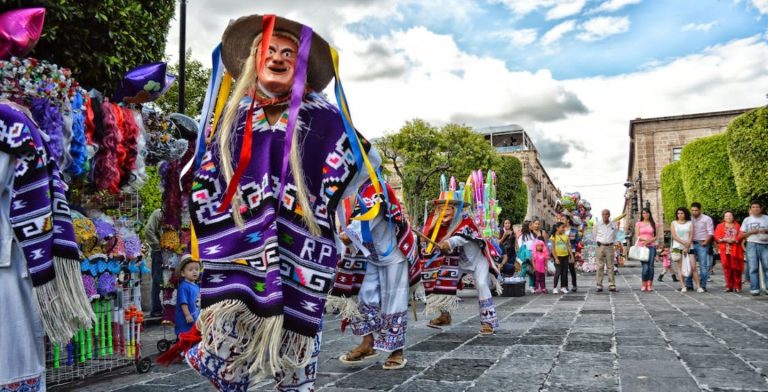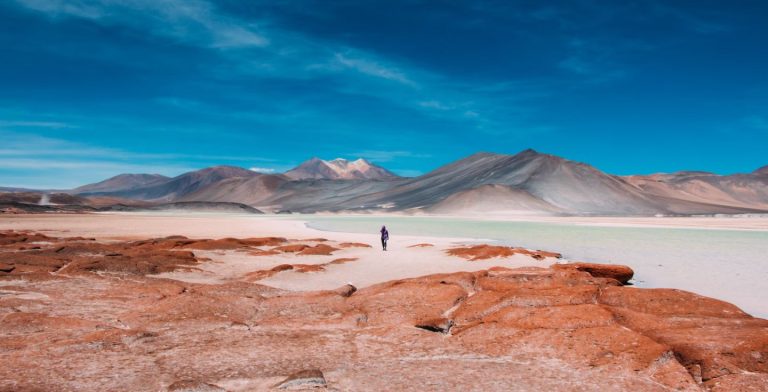Travel guide to Costa Rica: All you need to know
With our travel guide to Costa Rica, you won't miss a beat! Discover everything there is to see in this paradise.
You’ve decided to travel to Costa Rica but don’t know where to begin? No worries, we’ve got you covered. With our comprehensive travel guide, you’ll have all the information you need to travel to Costa Rica with no issues.
Read about how to get there and everything there is to do in this beautiful country. Plus, discover how to travel with peace of mind using the Holafly eSIM Costa Rica unlimited data plan.
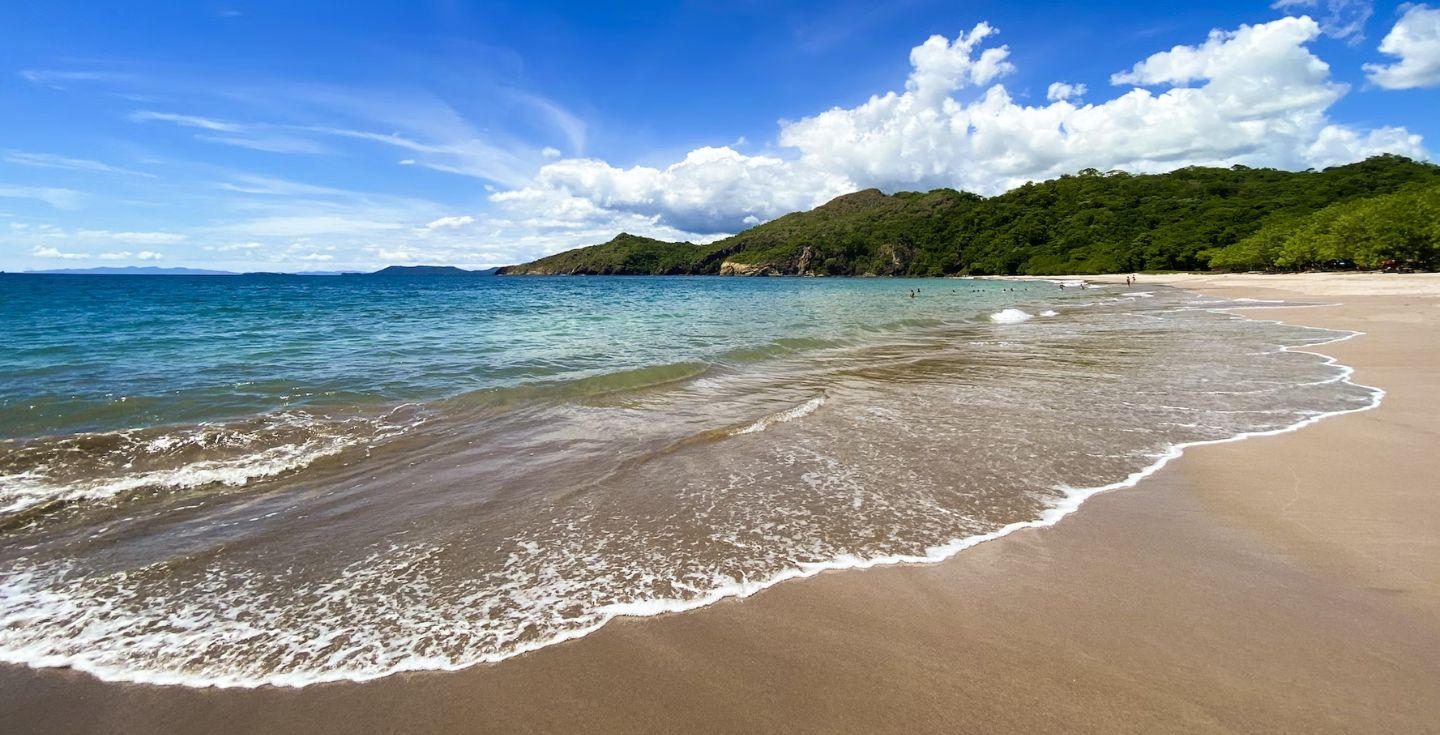
What you should know about Costa Rica: General info
Costa Rica is known for its breathtaking scenery and diverse animal life. The country is home to a wide range of natural wonders, from the sandy shores of the Pacific and Caribbean coasts to verdant jungles, active volcanoes, and cloud forests. Ecotourists from all over the world rush to Costa Rica to experience the country’s abundant flora and fauna. Also, you can go for adrenaline-pumping adventure activities like zip lining and white-water rafting. Nature and wildlife lovers will find paradise in the country’s many protected areas and national parks.
The climate in Costa Rica is tropical, with wet and dry seasons. Most visitors come during the dry season, which runs from December to April. This time of year features mild temperatures and mostly cloudless days. This season’s temperatures are normally between 70 and 90 degrees Fahrenheit (21 and 32 degrees Celsius). This makes it perfect for trips to the beach and other outdoor pursuits. Rainfall is higher, especially along the Caribbean coast, and temperatures are slightly lower during the rainy season (May–November). The Costa Rican Colón (CRC) is the legal tender; however, U.S. dollars are also regularly accepted. Costa Rica stays on Central Standard Time (CST) (UTC-6) all year long.
There are numerous places in Costa Rica where you can exchange currency. This includes banks, currency exchange offices (known as “casas de cambio”), and many hotels and resorts. Banks typically offer competitive exchange rates, and it’s advisable to exchange your money there. Specially if you have a significant amount to exchange.
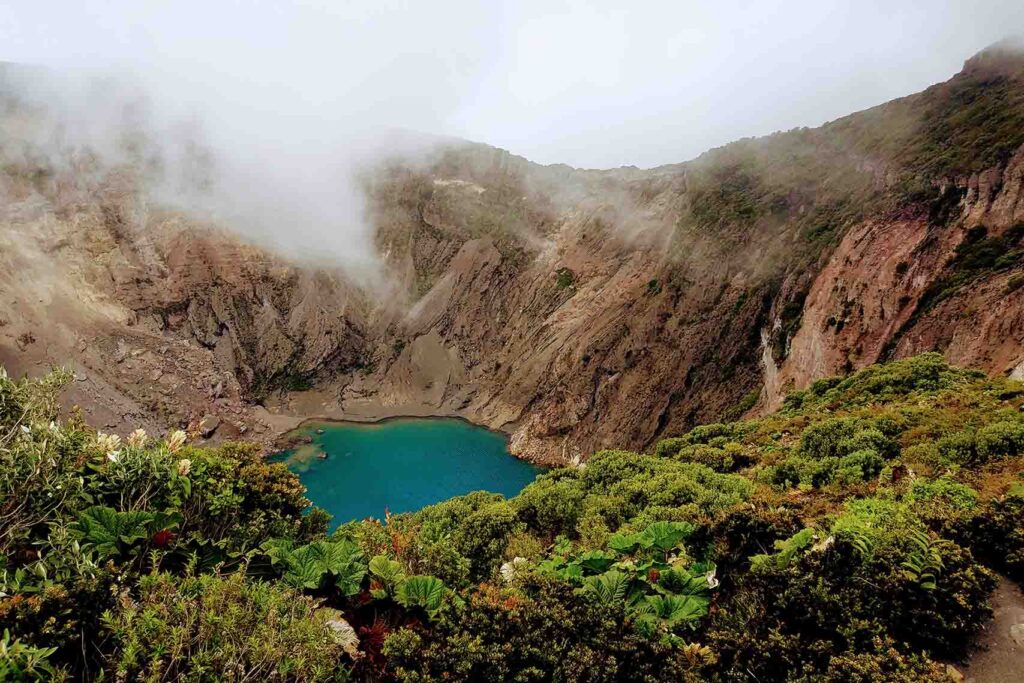
What to consider to traveling to Costa Rica
There are a number of details that must be attended to in order to have a wonderful Costa Rica vacation.
Requirements for a Visa
The visa requirements for entering Costa Rica are among the most relaxed in the world. Visitors from several countries, including the US, Canada, the EU, and many Latin American countries, do not need a visa to enter Costa Rica for up to 90 days. However, before visiting, it is essential to verify the precise visa requirements for your country. Your passport’s expiration date must be at least six months beyond your departure date at all times. Keep in mind that if you have a US tourist visa you may enter Costa Rica without applying for a new visa. Check the Costa Rican website of foreign affairs for more information.
Countries that require a visa to enter Costa Rica:
| Andorra | Slovenia | Peru |
| Belarus | Lithuania | Dominican Republic |
| Colombia | Malaysia | Thailand |
| Ecuador | Malta | Zimbabwe |
| Egypt | Nicaragua | Afghanistan |
| Republic of Moldova | Libya | Albania |
| Mongolia | Jordanian | Angola |
| Mozambique | Kazakhastan | Saudi Arabia |
| Myanmar (Burma) | Kenya | Algeria |
| Namibia | Kyrgyzstan | Armenia |
| Nauru | Kiribati | Azerbaijan |
| Nepal | Kuwait | Bahrain |
| Niger | Lesotho | Bangladesh |
| Nigeria | Lebanon | Benin |
| Oman | Liberia | Bosnia and Herzegovina |
| Pakistan | Macao, China | Botswana |
| Palau | Madagascar | Brunei-Darussalam |
| Palestine | Malawi | Burkina Faso (Alto Volta) |
| Papua New Guinea | Samoa | Burundi |
| Qatar | Santo Tome and Principe | Bhutan |
| Kingdom of Tonga | Senegal | Cape Verde |
| Dem. Republic of Laos | Serbia and Montenegro | Cambodia |
| Western Sahara | Seychelles | Cameroon |
| Republic of Syria | Sierra Leone | Comoros |
| Republic of Central Africa | Somalia | Ivory Coast |
| Republic of Macedonia | Sri Lanka | Croatia |
| Republic of Congo | Sudan | Cuba |
| Dem. Republic of Congo | Swaziland | Chad |
| China | Tanzania | Arab’s Emirates |
| North Korea | Tajikistan | Eritrea |
| Rwanda (East) | Timor | Ethiopia |
| Guinea | Togo | Fiji |
| Guinea-Bissau | Tunisia | Gabon |
| Equatorial Guinea | Turkmenistan | Gambia |
| Haiti | Tuvalu | Georgia |
| Hong Kong, China | Ukraine | Ghana |
| India | Uganda | Maldives |
| Indonesia | Uzbekistan | Mali |
| Iran | Vanuatu | Morocco |
| Iraq | Vietnam | Mauritius |
| Marianas Islands | Yemen | Mauritania |
| Marshall Islands | Djibouti | Micronesia |
| Solomon Islands | Zambia |
Culture and manners
The people of Costa Rica, affectionately called “Ticos,” are widely celebrated for their welcoming nature. As English may not be widely spoken in rural places, try to learn a few simple phrases in Spanish. This is a great way to demonstrate respect for the local culture.
In Costa Rica, a 10% service charge is commonly included to restaurant bills, but extra gratuity is always appreciated. It’s also courteous to take off your shoes before entering someone’s home. Also wear modest clothing when visiting a place of worship.
Security and Safety
Travelers should feel comfortable in Costa Rica, but it’s always smart to exercise common sense and avoid unnecessary risk. Keep a tight eye on your things because pickpocketing is more common in busy areas. Don’t show off your costly electronics or jewelry.
Avoiding stomach problems can be helped by sticking to bottled water and being careful about food cleanliness. If you want to have a safe and pleasurable outdoor adventure, listen to the advice of tour guides.
Connecting to the Internet
Ready for adventure?
In addition to all the recommendations, it is crucial to have mobile internet while traveling to Costa Rica. With Holafly’s unlimited data eSIM for Costa Rica you won’t worry about a thing! With 5% OFF. Code: MYESIMNOW5
Maintaining contact with the outside world while visiting Costa Rica is simple. Wi-Fi is available in most hotels, cafés, and public spaces, though its speed and reliability may vary. If you need a stable and reliable connection you might want to invest in an eSIM, your best option. A local SIM card or a mobile Wi-Fi hotspot is also useful but trickier to get.
Cellular coverage tends to be robust in urban centers and tourist hotspots, but spotty in more outlying places. Exploring the country’s stunning landscapes and attractions is made much easier with the use of a mobile data plan. A portable hotspot can be used for both navigation and communication
eSIM options
Companies like Holafly offer great deals and options to connect with an eSIM. You can easily get one online and activate it in seconds. Some even offer unlimited data and data sharing while you’re abroad. A compatible phone is all you need. In case you don’t have one, you can use a pocket WiFi or even a local SIM card.
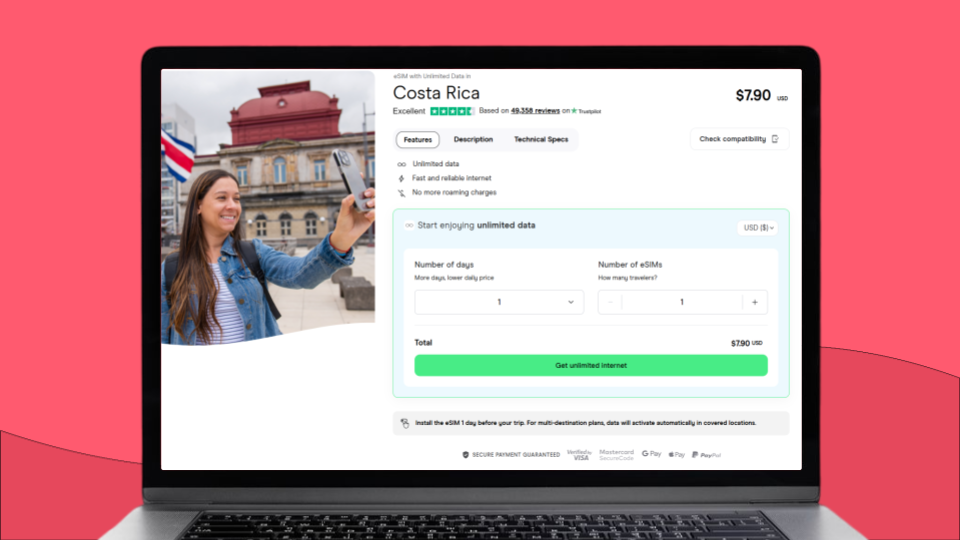
Ideal times to visit Costa Rica
Visitors visiting Costa Rica can experience firsthand the country’s rich traditions and lively celebrations. Filled with colorful and culturally significant holidays held throughout the year, here are a few of the most popular:
Holy Week
Semana Santa, which takes place in late March or early April, is a major religious celebration in Costa Rica. There are processions, dramatizations of Christ’s crucifixion, and other religious rites. During this time, many cities host vibrant parades, and worship services are held for both locals and visitors.
Independence Day
Second, on September 15th, Costa Ricans celebrate Dia de la Independencia, which commemorates the 1821 proclamation of independence from Spain. Parades, performances of musical and dance traditions, and the hoisting of the national flag are all part of the celebrations. Flags and local flag-themed decorations can be seen in cities and villages across the country.
Fiestas Palmares
One of the largest and most well-known celebrations in Costa Rica is the January-held Fiestas Palmares. Palmares, a Central Valley town, is the setting. At Fiestas Palmares, you can enjoy a lively celebration complete with rodeos, bullfights, live music, carnival rides, and more! This is a fantastic chance to learn about the cowboy lifestyle in Costa Rica.
Puntarenas and Limón Carnivals
Puntarenas and Limón, two coastal cities, have the largest Carnival celebrations in February. Parades filled with people dressed in bright costumes and performing traditional dances and songs are just part of the celebrations. It’s a great opportunity to see how the Afro-Caribbean has influenced Costa Rican culture firsthand.
Día de la Virgen de los Angeles
On August 2, Costa Ricans celebrate the religious festival known as Día de la Virgen de los Angeles. Travelers visit Cartago, Costa Rica, to visit the Baslica de Nuestra Señora de los Ángeles. This is a fascinating cultural and spiritual experience because it usually includes trekking for several days.
Envision Festival
Envision Festival is a music and arts festival held annually in February on the beautiful Uvita beach. This beach is along the Pacific coast. Live music, yoga, dancing, and workshops are all part of the Envision Festival. These activities draw people from all over the world searching for personal growth and self-improvement.
A visit to Costa Rica during one of its many celebrated holidays or festivals is a wonderful way to see the country’s friendly people, stunning landscapes, and rich cultural heritage. Checking the local calendar is a must because dates and specific events can change from year to year.
Which is the most convenient month to visit Costa Rica?
The best time to visit Costa Rica depends on the traveler and their desired activities and experiences. However, the country is popular with tourists all year. There are two distinct climate periods in this country: the dry and the wet.
Most tourists agree that the months of December through April, the dry season, are the best time to visit. Expect clear skies, pleasant temperatures, and little precipitation, making it ideal for the beach or the outdoors. It’s also the busiest time of year for vacationers, so high costs and crowded attractions should be expected.
Wet-season travelers should expect fewer tourists and cheaper rates from May through November. Rain is more common in the afternoons, but short-lived, so it doesn’t interfere with the morning and early afternoon. During the wet season, the terrain is at its lushest and most colorful. Many animals are more active, making it a perfect time for wildlife watchers.
Heavy rains and muddy roads might make it more difficult to reach some outlying regions. The best time to visit Costa Rica is when you want to go, whether you’re more concerned about the weather, your wallet, or the animals.

How to get to Costa Rica?
Located in the middle of Central America, Costa Rica is a fascinating and varied country that draws visitors from all over the world. You can get to this tropical paradise in Costa Rica in a number of ways: by air, by boat, or by taking an exciting overland trek.
By Air
Airports in San José (Juan Santamara) and Liberia (Daniel Oduber Quirós) serve as the primary international entry points to Costa Rica. Since these airports are used by so many different airlines, flying is by far the most convenient and prevalent means of entering the country. American Airlines, Delta Airlines, United Airlines, and JetBlue all offer flights to Costa Rica from cities across the United States. Connecting flights to Costa Rica are available from many European airports, including those of Iberia, Air France, and British Airways.
Traveling from Asia, Africa, and Oceania most likely requires layovers in other countries, but believe us, it’s definitely worth it. Give yourself the chance to have the adventure of a lifetime.
By Sea
The beautiful Pacific and Caribbean coastlines of Costa Rica are a major draw for cruise ship tourists. The major Costa Rican ports of Puntarenas and Limón are on the itineraries of several cruise companies, including Royal Caribbean, Carnival, and Norwegian Cruise Line. When you disembark, you can take advantage of shore excursions and guided tours to learn about the country’s fascinating wildlife, verdant woods, and stunning coastline.
By Land
Costa Rica is reachable by land from its neighboring nations, making it a suitable option for anyone seeking an adventurous road vacation. The most frequent land entry points are in the north from Nicaragua and in the south from Panama. The bus service between these nations and Costa Rica is reliable. The Paso Canoas crossing is the most common entry point for visitors coming from Panama, while the Peas Blancas crossing is the most common entry point for those coming from Nicaragua.
Once you arrive in Costa Rica, you can easily move about the country by taking advantage of the public bus system that links the various cities and communities.

One useful app is Skyscanner where you can check several different air route options. Make sure that you have a permit or visa if you require a layover.
Discover the unique Gastronomy of Costa Rica
The many areas and rich cultural history of Costa Rica all contribute to the country’s delicious food. Take a look at this sampling of Costa Rican cuisine from various regions and cities:
San José in the Central Valley
- Gallo Pinto: a dish of black beans and rice typically eaten with scrambled or fried eggs and considered a national breakfast staple.
- Casado: is a common dish served for lunch and consists of your choice of protein (chicken, fish, or beef) served with rice, beans, salad, and plantains.
- Chifrijo: is a common appetizer consisting of beans, rice, pork, and pico de gallo; it is typically served with tortilla chips.
Guanacaste (northwestern Pacific coast)
- Carne en Salsa: a hearty dish of beef stewed in a rich tomato-based sauce, typically eaten with rice and tortillas.
- Tamales: Banana-leaf-wrapped tamales filled with a variety of meats and vegetables are the signature dish of the Guanacaste region.
- Ceviche: is raw seafood that has been marinated in lime juice and sometimes includes other ingredients, including onions, cilantro, and bell peppers.
- Coconut rice and beans: a Caribbean spin on Gallo Pinto, is a classic dish in Limón (on the Caribbean coast), and is typically served with fried plantains, fish, or chicken. An aromatic stew of fish, shellfish, and vegetables cooked in coconut milk.
- Patty: refers to a pastry stuffed with meat or veggies and has its roots in Jamaican cuisine.
Puntarenas (Central Pacific Coast)
- Arroz with Mariscos: This dish mixes rice with a wide range of fresh seafood, typically cooked in a tomato-based sauce, and is a favorite of seafood lovers everywhere.
Grilled sea bass: with a spicy, tangy sauce of mayonnaise, mustard, and pickled vegetables is known as “Corvina a la Talla.” - Cheese: Monteverde is well-known for its artisanal cheese production. Monteverde (Cloud Forest Region). Consider queso fresco, a fresh cheese, or queso palmito, an aged cheese. A common snack in the area is Fried Cheese, which consists of cubes of cheese that have been battered and deep-fried, then typically accompanied by a sweet guava dip.
Nicoya Peninsula in the Northwest
- Chorreadas: are a type of sweet corn pancake that is popular in Central America.
- Chicheme: is a cinnamon and vanilla flavored maize drink.
Osa Peninsula (Southern Pacific Coast)
- Enjoy freshly caught fish such as snapper, shrimp, and octopus, often served simply with garlic and butter, on seafood platters from the Osa Peninsula (Southern Pacific Coast).
- Patacones: are green plantains that have been fried twice and typically come with a bean dip as an appetizer.
Top 10 cities to visit in Costa Rica
Immerse yourself in culture and delight in the top 5 cities to visit in Costa Rica. Visit museums, parks, theaters and much more. You’ll definitely find your cup of tea in this huge diversity.
- San José:
- National Theater: Explore the historic theater and cultural performances.
- Gold Museum: View pre-Columbian gold artifacts and indigenous heritage.
- Mercado Central: Experience local life, food, and shopping.
- La Sabana Park: Enjoy outdoor activities in a green urban park.
- Barrio Amón: Stroll through a charming colonial-era neighborhood.
- Liberia:
- Rincón de la Vieja National Park: Discover waterfalls, hot springs, and hiking trails.
- Guanacaste Museum: Learn about regional history and culture.
- Playas del Coco: Relax on beautiful beaches and enjoy nightlife.
- Papagayo Peninsula: Experience luxury resorts and pristine beaches.
- Santa Rosa National Park: Explore historic sites and nature.
- Manuel Antonio:
- Manuel Antonio National Park: Witness diverse wildlife and white-sand beaches.
- Espadilla Beach: Relax on a picturesque Pacific beach.
- Canopy Tours: Enjoy thrilling zip-line adventures.
- Quepos Marina: Dine and book boating excursions.
- Butterfly Gardens: Discover Costa Rica’s butterfly species.
- La Fortuna (Arenal Volcano Area):
- Arenal Volcano: Hike near an active volcano and soak in hot springs.
- La Fortuna Waterfall: Trek to an impressive waterfall.
- Arenal Hanging Bridges: Walk through suspended bridges.
- Arenal Observatory Lodge: Observe wildlife and volcano research.
- Tabacón Hot Springs: Relax in natural thermal pools.
- Puerto Viejo de Talamanca:
- Playa Cocles: Enjoy Caribbean vibes and surfing at the beach.
- Cahuita National Park: Explore coastal rainforest and snorkel in coral reefs.
- Jaguar Rescue Center: Get close to rescued wildlife.
- Bribri Indigenous Village: Learn about Bribri culture.
- Manzanillo Wildlife Refuge: Spot wildlife in a pristine refuge.
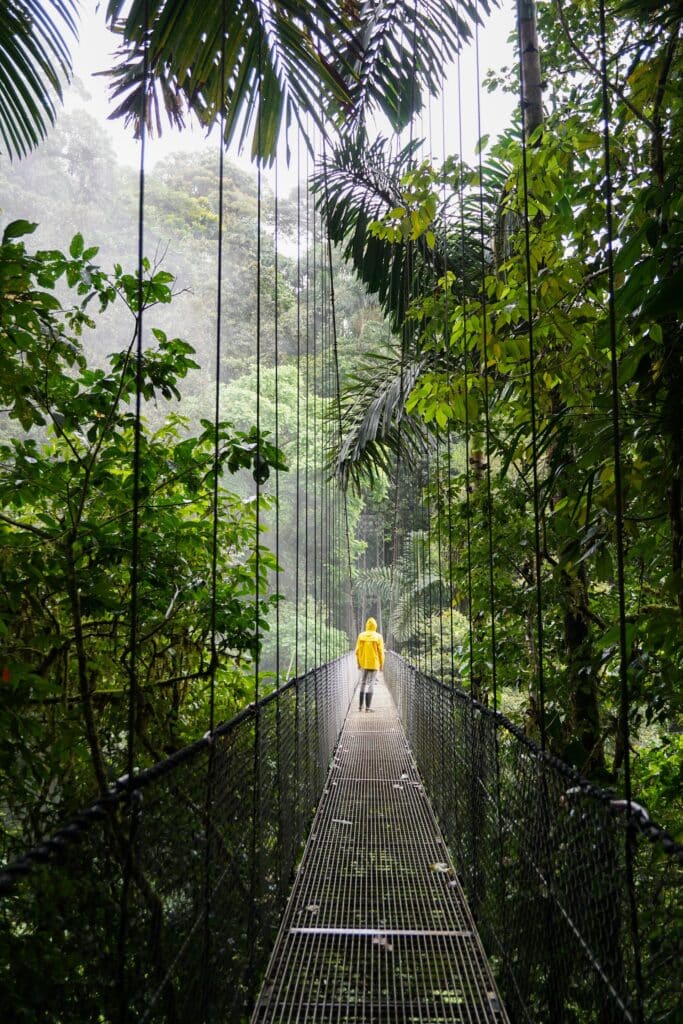

Costa Rica’s top 10 beaches
- Playa Manuel Antonio, in Manuel Antonio National Park, is a beautiful beach with white beaches and tranquil waves where you can see wildlife in the nearby rainforest.
- Playa Tamarindo (also known as Tamarindo Beach) Tamarindo Beach is a renowned surfing spot on the Pacific coast because of its reliable waves, exciting nightlife, and breathtaking sunsets.
- Playa Conchal is a peaceful paradise with beautiful waters and great snorkeling because to its distinctive broken seashell sands.
- Santa Teresa Beach, or Playa Santa Teresa, is number four on our list. Santa Teresa Beach has a chill atmosphere, beautiful sunsets, and excellent waves, making it a popular destination for surfers and yoga practitioners.
- Playa Flamingo is a crescent-shaped bay beach with calm waters, a marina, and opportunities for sailing, diving, and other water sports.
- Playa Montezuma (or Montezuma Beach) is number six on the list. Montezuma Beach, located on the Nicoya Peninsula, is a Bohemian haven known for its gorgeous beaches, tide pools, and thriving art community.
- Playa Hermosa (Guanacaste) is a “beautiful beach” with calm waves and a laid-back vibe, making it a top pick for people looking for peace and quiet.
- Cocles Beach (Playa Cocles) is number eight on the list. Cocles Beach, located close to Puerto Viejo, is a popular destination for surfers due to its large waves and beautiful surroundings.
- Playa Grande (Guánacaste) is a beautiful beach with great waves and a protected environment for leatherback sea turtles, a species that is in risk of extinction.
- Manzanillo Beach (Playa Manzanillo) is located in the Gandoca-Manzanillo Wildlife Refuge and is a beautiful beach with calm seas, coral reefs perfect for snorkeling, and a scenic coastal rainforest as a backdrop.
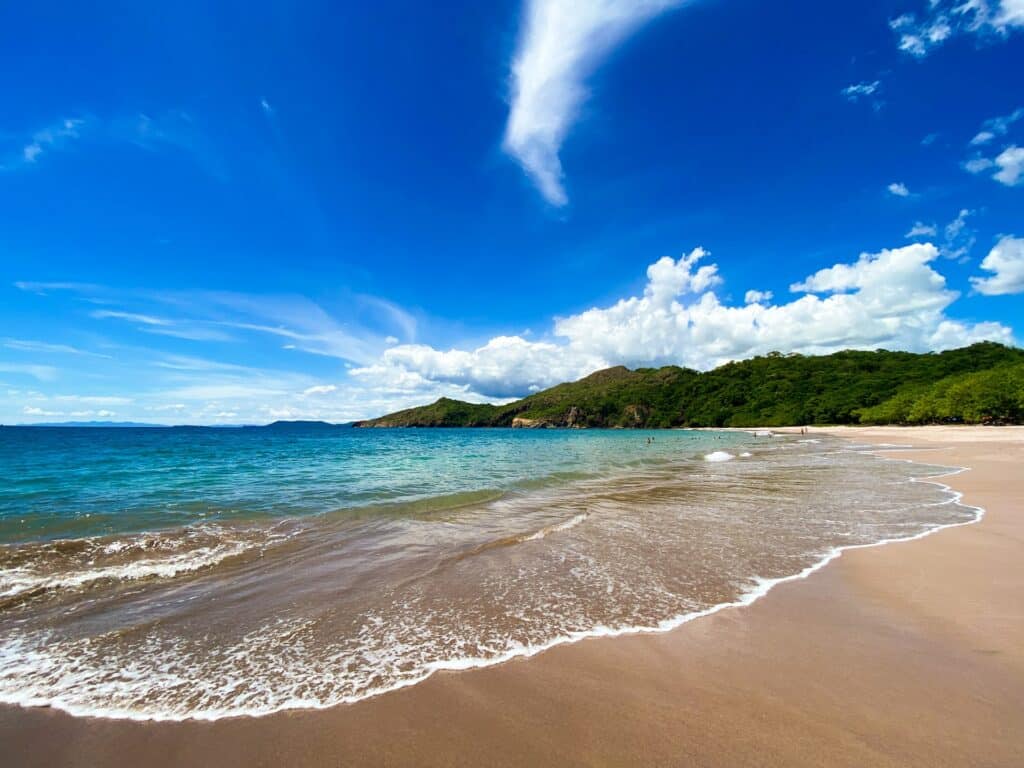
Top cultural tourism destinations in Costa Rica
- San José:
- The capital city and cultural hub of Costa Rica, San José offers museums, theaters, historic neighborhoods, and a lively urban atmosphere.
- Liberia:
- Known as the “Gateway to the Pacific,” Liberia is the starting point for many exploring the Pacific coast and is close to several national parks and beaches.
- Manuel Antonio:
- Home to Manuel Antonio National Park, this city offers lush rainforests, abundant wildlife, and stunning Pacific coast beaches.
- La Fortuna (Arenal Volcano Area):
- Arenal Volcano and hot springs make this city a major attraction, along with adventure activities like zip-lining and hiking.
- Tamarindo:
- A popular beach town, Tamarindo offers surfing, water sports, and vibrant nightlife, making it a top destination on the Pacific coast.
- Monteverde:
- Nestled in the cloud forests of Costa Rica, Monteverde is famous for its biodiversity, canopy tours, and nature reserves.
- Puerto Viejo de Talamanca:
- Located on the Caribbean coast, Puerto Viejo offers a unique blend of Afro-Caribbean culture, beautiful beaches, and wildlife.
- Quepos:
- The gateway to Manuel Antonio National Park, Quepos is a charming town with marinas, restaurants, and access to Pacific coast adventures.
- Dominical:
- Known for its laid-back atmosphere, Dominical is a surfing hotspot with beautiful beaches, waterfalls, and whale-watching opportunities.
- Jaco:
- A popular beach town close to San José, Jaco offers a mix of water sports, nightlife, and outdoor activities along the Pacific coast.

Where to experience ecotourism in Costa Rica?
Costa Rica is well-known for its dedication to ecotourism, and the country offers numerous locations where visitors may take in the country’s rich biodiversity and stunning scenery. The top ecotourism spots in Costa Rica include the following:
Parks and Eco Hotspots
- Manuel Antonio National Park. This park on the Pacific coast is renowned for its abundance of wildlife, beautiful beaches, and verdant woods. You can see monkeys, sloths, and many different birds while hiking the park’s pathways.
- Monteverde Cloud Forest: Monteverde’s cloud forests are home to a wide variety of flora and fauna, including the brilliant quetzal. Take part in exciting canopy tours and thrilling zip lines.
- Tortuguero National Park: Tortuguero, located on the coast of the Caribbean, is a crucial breeding location for sea turtles such as the green turtle and the leatherback turtle.
- Corcovado National Park: on the Osa Peninsula, is a wild area that is sometimes referred to as “the most biologically intense place on Earth.” Wild animals like jaguars, tapirs, and scarlet macaws can be seen while hiking through primary rainforests.
- Arenal Volcano National Park: Go on a hike, see a volcano, and soak in hot springs all around the famous Arenal Volcano.
- La Selva Biological Station: Guided tours, jungle treks, and opportunities to watch scientists at work may all be found at this OTS research station in Sarapiqu.
- The Gandoca-Manzanillo Wildlife Refuge: This refuge in the southern Caribbean safeguards a wide variety of habitats, including wetland areas, coral reefs, and tropical woods.
- The Pacuare River: is a great place to go white water rafting since it winds through beautiful jungle and there is a good chance of seeing wildlife.
- Cahuita National Park: Cahuita National Park is located on the Caribbean coast, and it features a coastal rainforest and coral reefs. Explore the underwater world and its many inhabitants by snorkeling or hiking.
- Santa Elena Reserve Cloud Forest: Santa Elena is another option for visiting a cloud forest with guided tours and birdwatching opportunities outside of Monteverde.
Touring Costa Rica: Transportation options
Because of the advanced network of roads and other conveyances, getting around Costa Rica is a breeze. Here are the most common ways to go around the country:
- Public Buses: Costa Rica has an extensive and reasonably priced public bus system. Both locals and visitors frequently use the bus system. The itineraries may be confusing at times, but they provide an inexpensive way to see the nation. Longer travel times are to be expected, especially in less populated areas.
- Private Shuttles: Private shuttle services are offered for those who are looking for a higher level of privacy and convenience during their trip. These are a wonderful choice for getting to specific places or for traveling in large groups. There are many different tour companies that offer private shuttle services.
- Car Rentals: If you want the freedom and convenience to explore less-visited parts of Costa Rica, renting a car is your best bet. International airports and major tourist destinations typically have branches of major vehicle rental services. However, be aware that road conditions can vary widely, with some areas even featuring gravel roads.
- Taxis: In urban and tourist locations, taxis are easily accessible. Metered taxis are available in larger cities like San José, whereas in more rural regions, passengers typically agree on a price with the driver beforehand. Verify that the taxi is licensed and has a working meter before getting in.
- Cycling: Certain regions of Costa Rica now have bike rental services and designated bike lanes for cyclists. Bicycling can be a great way to see the country’s scenery up close and personal.
What to buy in Costa Rica?
Return home with the best gifts from your journey abroad! Surprise everyone with a small but significant detail of the life and culture in Costa Rica. Here are some things you can take:
- Handmade Items: The handiwork of Costa Ricans has gained international renown. Ceramics, wooden sculptures, and paintings are wonderful keepsakes. You can get things like these at specialty stores and flea markets.
- Textiles: Costa Rica’s indigenous peoples create beautiful textiles with a wide range of colors and patterns. You may shop for traditional handicrafts, including woven bags, hammocks, and apparel.
- Masks: Masks from Costa Rica are called “mascaras,” and they are colorful and culturally significant. One of a kind and aesthetically pleasing, these masks are a common sight at festivals and other celebratory events.
- Chocolate: The quality of Costa Rica’s chocolate is being recognized on a global scale. Cacao nibs, chocolate bars, and tours of the chocolate factory are all available.
- Fine Dining Sauces: Delicious spicy sauces and salsas, frequently created with scorching indigenous peppers, are a staple of the Costa Rican culinary scene. Lizano sauce is a popular condiment in Costa Rica, so keep an eye out for bottles of it.
- Costa Rican Art: The paintings, sculptures, and mixed media pieces of modern and traditional Costa Rican artists can be found in the local art galleries.
- Products from the Rainforest: Buy organic soaps, shampoos, and skincare products formulated with rainforest plants to show your support for eco-friendly business methods. For example, try Rainforest Remedies.
Top shopping destinations in Costa Rica
Undoubtedly, Costa Rica boasts a plethora of retail venues that cater to diverse consumer preferences. Below are four well-known shopping areas in Costa Rica, each with a brief explanation.
- San José’s Central Market – also known as Mercado Central, is a prominent location in the city. Situated within the urban center, this vibrant marketplace is an opportune setting for the acquisition of mementos, indigenous handicrafts, farm-fresh edibles, and customary culinary delights.
- San José Suburbs – Multiplaza Escazú: – Multiplaza Escazú, a prominent retail center in Costa Rica, showcases a diverse range of foreign and local brands, dining establishments, and recreational amenities.
- Guanacaste – Liberia: – Liberia, the administrative center of the Guanacaste province, boasts a diverse array of establishments that cater to the discerning shopper, featuring a wide selection of traditional crafts, apparel, and souvenirs.
- Nicoya Peninsula – Montezuma: – Montezuma, situated on the Nicoya Peninsula, is a coastal town characterized by its bohemian atmosphere. It boasts a diverse selection of boutiques and shops that cater to various interests, offering a wide array of jewelry, apparel, and locally crafted handicrafts.
Frequently Asked Questions
Costa Rica is well acknowledged as a secure destination for travelers. As is customary in any given location, it is imperative to exercise prudence by ensuring the protection of personal goods and refraining from venturing into dimly lit regions during the night.
Costa Rica employs the Costa Rican Colón (CRC) as its official currency. Nevertheless, the acceptance of US dollars is widespread, and numerous establishments, particularly those located in tourist destinations, also accommodate credit card payments.
Steps to utilize an eSIM for mobile data in Costa Rica:
– Check your smartphone’s eSIM support.
– A Costa Rican or international carrier can sell you an eSIM plan.
– Scan the eSIM provider’s QR code or follow their activation instructions.
– You can use Costa Rican mobile data without a SIM card once activated.























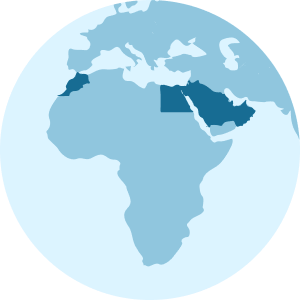





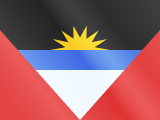








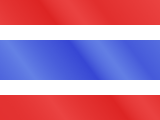







 Pay
Pay  Language
Language  Currency
Currency 


















 No results found
No results found






